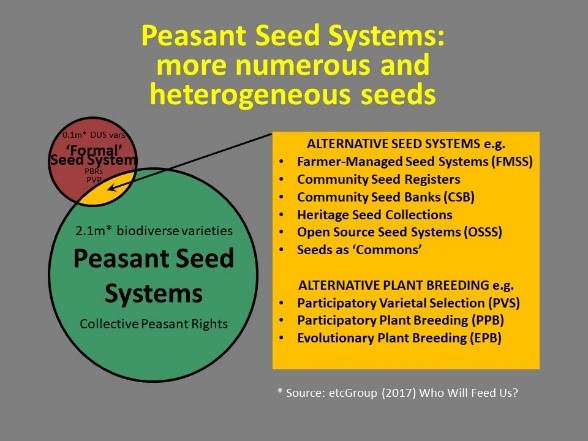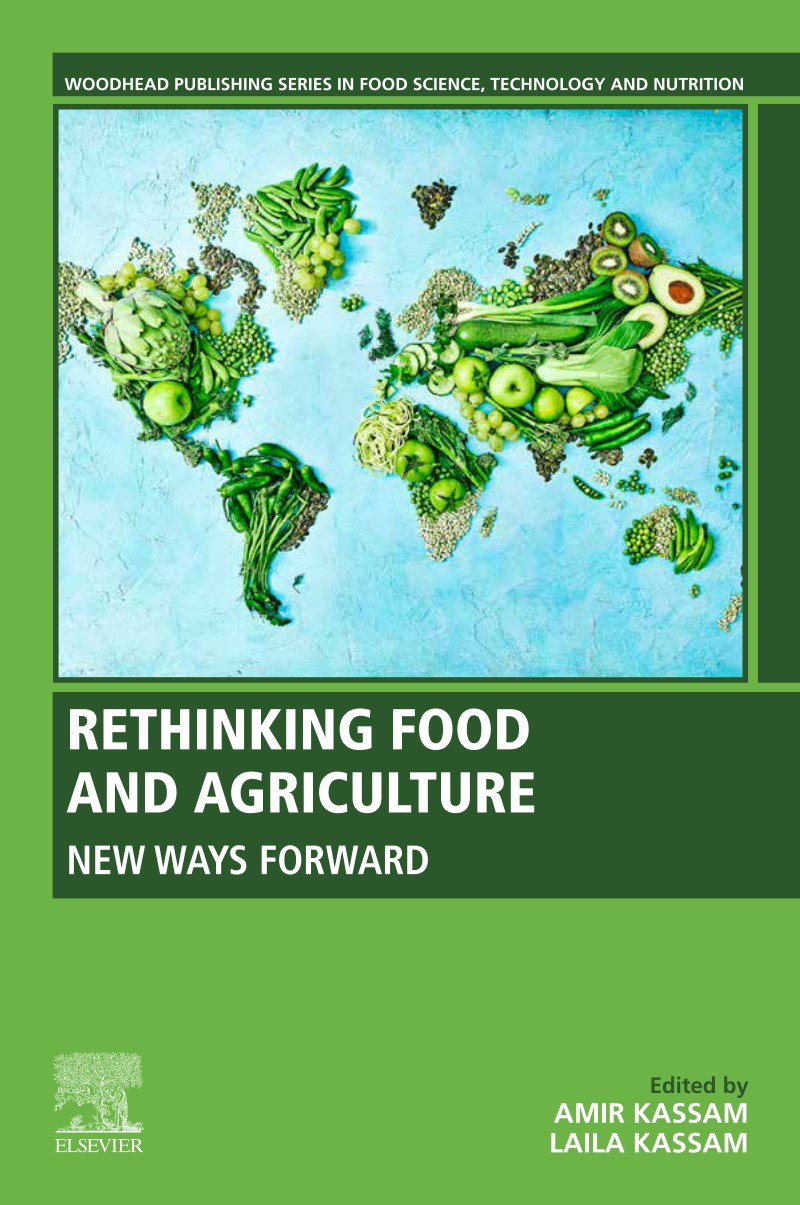Chapter 14
Sustaining Agricultural Biodiversity and Heterogeneous Seeds
by Patrick Mulvany
Abstract
There are social and environmental imperatives for sustaining agricultural biodiversity in all food systems, not least because its dynamic management helps confront the climate, biodiversity, and nutrition crises. It is broad in origin, scope, and functioning and has coevolved with people over millennia, embracing the diversity of all living beings within agroecosystems. It is much more than the diversity of seeds of the relatively few crops that are dominant in the industrial food system. There are many threats to agricultural biodiversity, especially from industrial monocultures of proprietary seeds, yet its international governance is broadly hostile and ineffective in reducing its erosion. Its control is contested by competing forces of which the ecological food provision coalition, that champions peasant agroecology and food sovereignty, defends and promotes heterogeneous seeds and high levels of agricultural biodiversity embedded within all production systems. This should become a dominant attribute of responsible agriculture and food systems.
Extract
Agricultural biodiversity is intentionally heterogeneous
Agricultural biodiversity has been developed over millennia by women and men peasant farmers and gardeners, herders and pastoralists, fishers, forest dwellers and other small-scale food providers. It encompasses the variety and variability of animals, plants and micro-organisms which are necessary to sustain key functions of the agroecosystem, its structure and processes for, and in support of, all food production.
The heterogeneity, i.e. embedded diversity, of seeds, livestock breeds, aquatic organisms and wider agricultural biodiversity, at genetic, species and ecosystems levels, within agroecological food production systems, is essential for resilient, sustainable and biodiverse food production. Enhancing heterogeneous seeds and livestock breeds on-farm, in gardens, and within fields, pastures, waters, and wherever else food is produced, is vital for people and the planet. These heterogeneous seeds and agricultural biodiversity underpin and depend upon agroecology and food sovereignty. They have not only provided the food for the world over millennia but peasants’ biodiverse agroecology, based on heterogeneous seeds and a broad range of agricultural biodiversity above and below ground within agroecosystems, still provides nutritious food for most people in ways that protect biodiversity and mitigate climate change.
Food systems based on biodiverse agroecology, especially as practiced by peasants in the framework of food sovereignty, can mitigate the existential climate, biodiversity and nutrition crises. But key to the effectiveness of this approach is that heterogeneity is embedded in all the seeds, breeds and agroecosystems used for food production. Agricultural biodiversity is heterogeneous and is intentionally enhanced through the dynamic management of varieties, breeds, species and ecosystems.
Threats to agricultural biodiversity
Industrial monocultures, intensive livestock production and large-scale mechanised fisheries, promoted profitably by powerful corporations, are the main cause of the loss of biodiversity and are also principal drivers of climate change. Few species of plants and animals are dominant in the industrial food system. More significantly, it is the rapidly diminishing number of varieties of crops and breeds of animals –currently grown and raised, in monocultures, in fields, pastures, waters and CAFOs – that is of greatest concern. These proprietary seeds and breeds are overwhelmingly favoured by the international governance architecture that should, as a priority support the in situ conservation of all agricultural biodiversity. Its effects are hostile, including trade rules, which may not discriminate in favour of the conservation of agricultural biodiversity. Peasant Seed Systems are ‘collateral damage’ in the international governance of seeds, which can criminalise those who enhance biodiverse agroecology, based on heterogeneous seeds and agricultural biodiversity. In contrast, peasant seed systems, with twenty-fold more numerous varieties of peasant seeds, adapted to territorial diversity, are governed by peasants themselves, respecting their collective rights (see Fig. 1). International governance is contested by the ecological food provision coalition, which champions high levels of agricultural biodiversity and heterogeneous seeds embedded within all production systems.
Figure 1: Peasant Seed Systems: more numerous and heterogeneous seeds

Prioritising biodiverse and heterogeneous peasant agroecology
The production practices of peasant agroecology are based on ecological principles including building life in the soil and waters, recycling nutrients, and the dynamic management of biodiversity. Optimal functioning of ecosystem processes, at all levels, depends on the degree of inter- and intra-specific, and inter- and intra-varietal, heterogeneity that exists within biodiverse agroecosystems, at all scales of production, in gardens, fields, pastures, ponds, forests, landscapes, watersheds and coastal waters. The development of these more ecologically complex, biodiverse and heterogeneous ecosystems should be the priority for scientific research and innovation, encompassing indigenous knowledge and peasant practices.
Heterogeneous seeds and agricultural biodiversity – the basis for responsible agriculture and food systems
This heterogeneity needs to be expressed:
- within the plant varieties, breeds of livestock and aquatic organisms being cultivated, raised or harvested, and within the sub-species of ‘associated biodiversity’ that provide essential ecosystem functions and support production (i.e. intra-varietal and inter-varietal biodiversity);
- in the biodiversity of species of crops, livestock and associated species, above and below ground, such as soil organisms, pollinators, predators and microbiota in soils, rumens and waters; (i.e. intra-specific and inter-specific biodiversity); and
- in the biodiversity of the surrounding agroecosystems as well – from within fields and pastures and out to landscape and watershed levels (i.e. ecosystem biodiversity).
It is therefore imperative not only to maintain and enhance the diversity of crop species and varieties on-farm, as peasant agroecology and peasant seed systems achieve, but it is also essential to sustain their heterogeneity as well as enhance the number and heterogeneity of associated species above and below ground. For example, more heterogeneous populations of soil microbiota in organically managed, biodiversity-rich soils, improve soil health and hence the productivity of plants and the diversity of rumen and digestive tract micro-organisms. Despite the hostile environment of the dominant governance architecture, increasing heterogeneity in production systems can be officially sanctioned. For example, organic heterogeneous seeds and heterogeneous ‘populations’ of single species, can be marketed in the EU without complying with the requirements for registration and certification needed to register a uniform variety.
Increasing the embedded heterogeneity within the food we eat could easily be promoted, if, and with due homage to Michael Pollan, one could urge citizens to: ‘eat more biodiversity, mainly heterogeneous plants, but not too much!’ And increasing the spread of knowledge of what needs to be done could be easily achieved if pushed by public-interest bodies, governments and, collectively, in the United Nations with support from Civil Society (as in e.g. the Committee on World Food Security).The UN should also exercise its responsibilities to strictly regulate corporations.
To achieve the required changes, two approaches could be useful:
- New governance priorities in place of, or separate from, those that currently exist, which would put primacy on heterogeneous seeds, breeds and agroecosystems, would be an effective way for governments to demonstrate an intention to encourage and enforce changes. Priorities for this governance would include respecting the Rights of peasants, and putting control of heterogeneous seeds, livestock breeds and wider agricultural biodiversity back in their hands.
- A parallel approach, which is more in the control of Civil Society and social movements, is to ensure that in all relevant programmes and processes promoted and practiced by them, they are prioritising the enhanced heterogeneity of seeds, breeds and agroecosystems within production systems. Approaches, which, while espousing local determination of, and control over, localised food systems, which do not explicitly embed heterogeneity in the systems they promote should be enhanced. In research, development and outreach programmes intended to improve agroecological production systems, there is a need to explicitly include goals of enhancing heterogeneous seeds, livestock breeds and wider agricultural biodiversity.
To know if these approaches are really working in practice, a new indicator for sustainability of food systems, based on measuring heterogeneity of seeds and breeds, and other agricultural biodiversity above and below ground, within all food production systems, could be useful. Widespread use of such an indicator, could help highlight and reverse the devastating declines in agricultural biodiversity in many, mainly industrial, production systems, while supporting peasants’ biodiverse agroecology. From peasants, their social movements and civil society organisations to agricultural policy planners, monitoring the changes in the heterogeneity of agricultural biodiversity within any land-based, aquatic or marine production system should become a norm. An indicator of heterogeneity of agricultural biodiversity within production systems should become a dominant metric of responsible agriculture and food systems.
Read a blog based on this chapter entitled Seeking New Agreements for Working with Nature through Enhancing Agricultural Biodiversity.
About The Author

Patrick Mulvany, MA, C.Biol
Patrick Mulvany is an Honorary Research Fellow at the Centre for Agroecology, Water and Resilience of Coventry University and a member of the UK’s Food Ethics Council. His work focuses on policy and practice to realise food sovereignty, enhance agricultural biodiversity and agroecology, and the related issues of the governance of food, environment and technology. He was formerly the senior policy adviser to Practical Action/ITDG and Co-chair of the UK Food Group and the NGO Committee of the CGIAR; and was an NGO member of IAASTD’s governing bureau, FAO’s Technical Advisory Group for the State of the World’s Biodiversity for Food and Agriculture, and BBSRC’s Bioscience for Society Strategy panel. He’s been active in the civil society lobbies on agricultural biodiversity at FAO and the CBD as well as in the international, regional and national food sovereignty networks, including the Agricultural Biodiversity working group of the IPC for Food Sovereignty.
Will Gene-Edited and other GM Crops Fail Sustainable Food Systems? by Allison K Wilson
Healthy Diets as a Guide to Responsible Food Systems by Shireen Kassam, David Jenkins, Doug Bristor and Zahra Kassam



